Efficacy of an immunotoxin to folate receptor beta in the intra-articular treatment of antigen-induced arthritis
- PMID: 22551402
- PMCID: PMC3446483
- DOI: 10.1186/ar3831
Efficacy of an immunotoxin to folate receptor beta in the intra-articular treatment of antigen-induced arthritis
Abstract
Introduction: We previously demonstrated that synovial sublining macrophages express folate receptor beta (FRβ). The aim of this study was to evaluate the efficacy of intra-articular administration of a recombinant immunotoxin to FRβ for treating rat antigen-induced arthritis.
Methods: A monoclonal antibody (mAb) to rat FRβ was produced by immunizing mice with B300-19 cells (murine pre-B cells) transfected with the rat FRβ gene. Recombinant immunotoxin was prepared by conjugating the Fv portion of the anti-rat FRβ mAb heavy chain with a truncated Pseudomonas exotoxin A and the Fv portion of the anti-rat FRβ mAb light chain. Antigen-induced arthritis was induced through intra-articular injection of methylated bovine serum albumin (mBSA) after two subcutaneous injections of mBSA and complete Freund's adjuvant. Immunotoxin was intra-articularly injected into the arthritis joint every other day for seven days after arthritis onset. Joint swelling was measured and histological scores of inflammation, synovial thickness, cartilage, and bone destruction were determined. Immunohistochemistry was performed to detect osteoclast and osteoclast precursor FRβ-expressing macrophages and cathepsin K-positive cells on day 21.
Results: Intra-articular administration of the immunotoxin attenuated joint swelling (61% suppression; P < 0.01 compared to the control on day 21) and improved histological findings, particularly cartilage and bone destruction (scores of rats treated with control versus the immunotoxin: 2.2 versus 0.5; P < 0.01), by reducing the number of FRβ-expressing macrophages and cathepsin K-positive cells.
Conclusions: Intra-articular administration of an immunotoxin to FRβ is effective for improving rat antigen-induced arthritis.
Figures

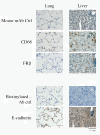
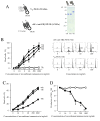
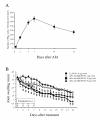
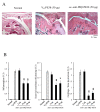
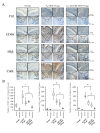
Similar articles
-
Effectiveness of anti-folate receptor beta antibody conjugated with truncated Pseudomonas exotoxin in the targeting of rheumatoid arthritis synovial macrophages.Arthritis Rheum. 2005 Sep;52(9):2666-75. doi: 10.1002/art.21228. Arthritis Rheum. 2005. PMID: 16142741
-
In vitro and in vivo efficacy of a recombinant immunotoxin against folate receptor beta on the activation and proliferation of rheumatoid arthritis synovial cells.Arthritis Rheum. 2006 Oct;54(10):3126-34. doi: 10.1002/art.22082. Arthritis Rheum. 2006. PMID: 17009233
-
Depletion of folate receptor β-expressing macrophages alleviates bleomycin-induced experimental skin fibrosis.Mod Rheumatol. 2014 Sep;24(5):816-22. doi: 10.3109/14397595.2013.879415. Epub 2014 Feb 5. Mod Rheumatol. 2014. PMID: 24498991
-
The folate receptor β as a macrophage-mediated imaging and therapeutic target in rheumatoid arthritis.Drug Deliv Transl Res. 2019 Feb;9(1):366-378. doi: 10.1007/s13346-018-0589-2. Drug Deliv Transl Res. 2019. PMID: 30280318 Free PMC article. Review.
-
Folate Receptor Beta for Macrophage Imaging in Rheumatoid Arthritis.Front Immunol. 2022 Feb 2;13:819163. doi: 10.3389/fimmu.2022.819163. eCollection 2022. Front Immunol. 2022. PMID: 35185910 Free PMC article. Review.
Cited by
-
Single- versus Dual-Targeted Nanoparticles with Folic Acid and Biotin for Anticancer Drug Delivery.Pharmaceutics. 2021 Mar 3;13(3):326. doi: 10.3390/pharmaceutics13030326. Pharmaceutics. 2021. PMID: 33802531 Free PMC article. Review.
-
A Novel Treatment for Glomerular Disease: Targeting the Activated Macrophage Folate Receptor with a Trojan Horse Therapy in Rats.Cells. 2021 Aug 17;10(8):2113. doi: 10.3390/cells10082113. Cells. 2021. PMID: 34440885 Free PMC article.
-
Folate-based radiotracers for PET imaging--update and perspectives.Molecules. 2013 Apr 29;18(5):5005-31. doi: 10.3390/molecules18055005. Molecules. 2013. PMID: 23629756 Free PMC article.
-
Serum-soluble folate receptor β as a biomarker for the activity of rheumatoid arthritis synovitis and the response to anti-TNF agents.Clin Rheumatol. 2018 Nov;37(11):2939-2945. doi: 10.1007/s10067-018-4202-3. Epub 2018 Jul 18. Clin Rheumatol. 2018. PMID: 30022370
-
Targeting folate receptor beta on monocytes/macrophages renders rapid inflammation resolution independent of root causes.Cell Rep Med. 2021 Oct 19;2(10):100422. doi: 10.1016/j.xcrm.2021.100422. eCollection 2021 Oct 19. Cell Rep Med. 2021. PMID: 34755134 Free PMC article.
References
-
- McHugh KP, Shen Z, Crotti TN, Flannery MR, O'Sullivan RP, Purdue PE, Goldring SR. The role of cell-substrate interaction in regulating osteoclast activation: potential implications in targeting bone loss in rheumatoid arthritis. Ann Rheum Dis. 2010;69(Suppl 1):i83–85. doi: 10.1136/ard.2009.120188. - DOI - PubMed
-
- Bresnihan B, Pontifex E, Thurlings RM, Vinkenoog M, El-Gabalawy H, Fearon U, Fitzgerald O, Gerlag DM, Rooney T, van de Sande MG, Veale D, Vos K, Tak PP. Synovial tissue sublining CD68 expression is a biomarker of therapeutic response in rheumatoid arthritis clinical trials: consistency across centers. J Rheumatol. 2009;36:1800–1802. doi: 10.3899/jrheum.090348. - DOI - PubMed
Publication types
MeSH terms
Substances
LinkOut - more resources
Full Text Sources
Other Literature Sources
Medical

